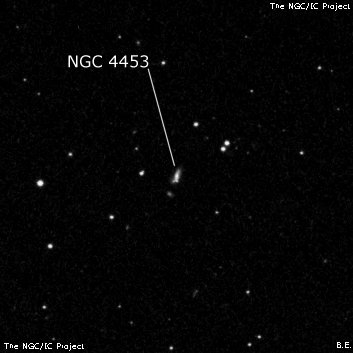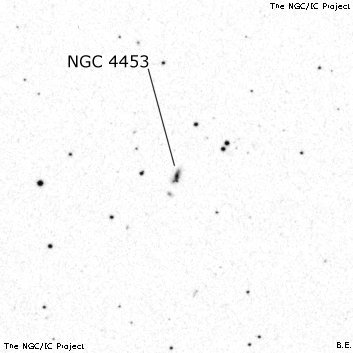NGC/IC Project Restoration Effort
(This is a very very beta version)
NGC4453


Basic Information
Location and Magnitude
Right Ascension: 12:28:46.8
Declination: +6:30:44
Constellation: VIR
Visual Magnitude: 14.9
Historic Information
Discoverer: Herschel J.
Year of discovery: 1830
Discovery aperture: 18.3
Observational
Summary description: F, pS, bM, r
Sub-type: Sb
Corwin's Notes
=====
NGC 4453. While there is probably no question about the identity of JH's
object, h 1283 (but see below), there is a problem with WH's (H II 26).
Dreyer notes in the Scientific Papers that the observations in Sweep 131 are
"very unsatisfactory" (a criticism that extends to Sweep 132 as well; see NGC
4577 for more). This was the only nebula found in Sweep 131, so there is
little to compare it with aside from the "unsatisfactory" observations of the
stars.
The galaxy that JH found is "eF" in his catalogue -- this does indeed match
CGCG 042-121 with V = 15.4 and B = 16.1 (SDSS) -- while WH's is "pB, pL,
brighter toward the following side." Dreyer suggests a possible identity with
NGC 4430, but that is 20 arcmin in Dec off the position of N4453 and 30
seconds off in RA. He also has a note from WH that there is a "very large
star" 9 minutes, 6 seconds preceding and 22 arcmin south of the nebula.
Assuming that N4430 is indeed WH's object, the description fits. But there is
no star at WH's offsets. The one that Dreyer suggests (BD +6 deg 2588) is
7 minutes, 29 seconds preceding, and 13 arcmin south. A somewhat brighter
star (HD 107258) is at 12 19 55.3, +05 40 18 (J2000.0) -- 7 minutes, 31
seconds preceding, and 35 arcmin south. Neither is a good match for WH's
offsets.
JH's much fainter galaxy (the one that we adopt as NGC 4453), however, is 9
min 0 sec following, and 28 minutes north of BD +6 deg 2588, a better --
though not prefect -- match to WH's observation. But the galaxy can hardly be
the one WH saw; it is far too faint, too small, and is not at all brighter
toward the east. There is also a double star a couple of arcminutes northwest
that could well be the object JH saw. The stars are considerably brighter
than the galaxy at V = 14.4, B = 15.1; and V = 15.0, B = 16.1; again, from the
SDSS.
At the end of all this, I'm leaning toward adopting NGC 4430 as II 26, though
with considerable uncertainty. At this point, you are probably asking "Why
bother? We know where NGC 4453 is." Knowing which galaxy is II 26 will help
with the puzzle of NGC 4577 = H III 13, found the same night, and supposedly
referred to the same star. See NGC 4577 for more.
Steve's Notes
=====
NGC 4453
17.5" (4/21/90): very faint, extremely small, round. Unusual appearance with mag 14 star nvolved near the south edge and also an extremely faint 16th magnitude star or companion superimposed. NGC 4430/NGC 4432 lie 25' SW.



